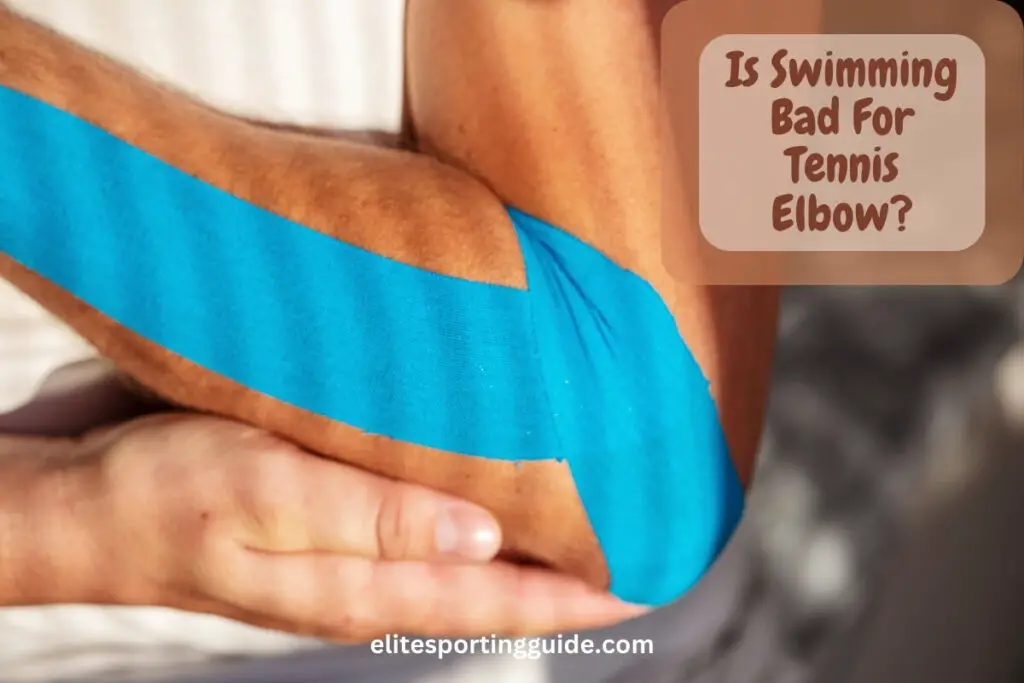In recent discussions surrounding the management of tennis elbow, one recurring question has emerged: is swimming detrimental to this condition?
While tennis elbow, or lateral epicondylitis, presents challenges for individuals seeking physical activity, swimming stands out as a potential low-impact solution.
In this article, we look into the relationship between swimming and tennis elbow, exploring its potential benefits, considerations, and strategies for managing symptoms effectively.
By addressing common concerns and offering insights from experts in the field, we aim to provide clarity on whether swimming is indeed detrimental or beneficial for individuals grappling with tennis elbow.
Is Swimming Bad For Tennis Elbow?
Swimming can be beneficial for tennis elbow due to its low-impact nature and ability to strengthen muscles without putting excessive strain on the affected elbow joint. However, certain swimming strokes or improper technique may exacerbate symptoms, so individuals should pay attention to their comfort level and modify their approach accordingly. Overall, when done correctly and with proper guidance, swimming can often be a safe and effective form of exercise for individuals with tennis elbow.
Understanding Tennis Elbow
Tennis elbow, medically known as lateral epicondylitis, is a common overuse injury that affects the tendons in the elbow.
The condition typically occurs due to repetitive motion and strain on the tendons that attach to the bony prominence on the outside of the elbow.
Despite its name, tennis elbow isn’t limited to tennis players; it can affect anyone who engages in activities that involve repetitive arm movements, such as painting, typing, or playing musical instruments.
The main tendon involved in tennis elbow is the extensor carpi radialis brevis, which becomes inflamed and painful.
Individuals with tennis elbow often experience discomfort and pain on the outer part of the elbow, which can radiate down the forearm.
Understanding the causes, symptoms, and risk factors associated with tennis elbow is essential for proper diagnosis and effective management of this condition.
Benefits of Swimming for Physical Rehabilitation

1. Reduced Joint Impact: Swimming provides a low-impact environment that reduces stress on the joints, including the affected elbow, which can help alleviate pain associated with tennis elbow.
2. Increased Circulation: The rhythmic movements involved in swimming promote blood flow to the muscles and tendons, aiding in the delivery of oxygen and nutrients to the affected area, potentially enhancing healing and reducing inflammation.
3. Improved Range of Motion: Swimming involves various strokes that require the arm to move through different planes of motion, which can help improve flexibility and range of motion in the elbow joint, counteracting stiffness associated with tennis elbow.
4. Strengthening of Supporting Muscles: Swimming engages multiple muscle groups, including those in the arms, shoulders, and upper back, which can help strengthen supporting muscles around the elbow joint, providing stability and reducing strain on the affected tendons.
5. Enhanced Rehabilitation Potential: Swimming offers a controlled environment where individuals can gradually increase activity levels and rehabilitate the affected elbow without exacerbating symptoms, allowing for a progressive recovery process.
6. Therapeutic Effects of Water Resistance: The resistance provided by water during swimming can help build muscle strength and endurance without placing excessive stress on the joints, offering a gentle yet effective form of rehabilitation for tennis elbow.
7. Psychological Benefits: Engaging in swimming as part of a rehabilitation program can promote a sense of well-being and accomplishment, reducing stress and anxiety commonly associated with chronic pain conditions like tennis elbow.
Considerations for Individuals with Tennis Elbow
1. Avoid Overuse: Individuals with tennis elbow should avoid activities that exacerbate symptoms, such as repetitive gripping, lifting heavy objects, or performing strenuous motions with the affected arm.
2. Proper Technique: When engaging in activities that involve the use of the arms, such as sports or manual labor, it’s essential to maintain proper technique and form to minimize strain on the tendons and muscles around the elbow joint.
3. Rest and Recovery: Adequate rest is crucial for allowing the injured tendons to heal properly. Individuals with tennis elbow should avoid overexertion and allow sufficient time for rest and recovery between activities.
4. Ice and Compression: Applying ice packs and using compression techniques can help reduce inflammation and alleviate pain associated with tennis elbow.
It’s advisable to apply ice for short periods, multiple times a day, especially after activities that may aggravate symptoms.
5. Gradual Progression: When reintroducing physical activities after a period of rest or injury, it’s important to start gradually and progressively increase intensity and duration to avoid overloading the affected tendons and muscles.
6. Ergonomic Modifications: Making ergonomic adjustments to workstations, sports equipment, or tools can help reduce strain on the elbows and minimize the risk of exacerbating tennis elbow symptoms.
This may include using ergonomic keyboards, adjusting desk heights, or using assistive devices.
7. Stretching and Strengthening Exercises: Incorporating specific stretching and strengthening exercises for the forearm, wrist, and elbow muscles can help improve flexibility, range of motion, and muscle strength, which are essential components of tennis elbow rehabilitation.
8. Protective Measures: Wearing elbow braces or straps during activities that may strain the affected tendons can provide additional support and stability, reducing discomfort and preventing further injury.
Strategies to Manage Tennis Elbow While Swimming

1. Modify Swimming Strokes: Opt for swimming strokes that minimize strain on the affected elbow, such as the breaststroke or backstroke, which typically involve less repetitive arm movements compared to freestyle or butterfly strokes.
2. Gentle Warm-Up: Begin each swimming session with a gentle warm-up routine to prepare the muscles and tendons around the elbow for activity.
Incorporate slow and controlled movements to gradually increase blood flow and flexibility.
3. Focus on Technique: Pay close attention to your swimming technique to ensure proper form and alignment, which can help distribute workload evenly across muscle groups and reduce strain on the affected elbow.
4. Use Swimming Aids: Consider using swimming aids such as paddles or fins to reduce the workload on the arms and shoulders, allowing individuals with tennis elbow to focus on lower-body propulsion while swimming.
5. Limit Intensity and Duration: Avoid overexertion by limiting the intensity and duration of swimming sessions, especially if you experience discomfort or pain in the affected elbow.
Gradually increase the intensity and duration of swimming workouts as your symptoms improve.
6. Incorporate Rest Periods: Intersperse periods of rest and recovery during swimming workouts to prevent overuse and minimize fatigue in the affected elbow
Take breaks as needed to allow the muscles and tendons to recuperate.
7. Ice Therapy After Swimming: Apply ice packs to the affected elbow following swimming sessions to reduce inflammation and alleviate pain. Ice therapy can help soothe soreness and promote recovery in the affected area.
8. Listen to Your Body: Pay attention to any warning signs or symptoms of worsening tennis elbow during swimming activities, such as increased pain, swelling, or limited range of motion.
Modify your swimming routine or seek medical advice if symptoms persist or worsen over time.
9. Consider Alternative Activities: If swimming exacerbates symptoms of tennis elbow despite modifications, consider alternative low-impact activities such as water aerobics, aqua jogging, or pool walking to maintain fitness and rehabilitation without aggravating the condition.
Post you may be interested in: Can Swimming Damage Your Knees?
Consultation and Professional Guidance
Consultation and professional guidance are invaluable resources for individuals managing tennis elbow or any musculoskeletal condition.
Seeking advice from healthcare professionals, such as orthopedic specialists, physical therapists, or sports medicine physicians, can provide personalized assessment, diagnosis, and treatment options tailored to individual needs.
These professionals can offer expert insight into the underlying causes of tennis elbow, recommend appropriate rehabilitation exercises, and provide guidance on modifying activities to prevent further injury.
Additionally, they may employ modalities such as manual therapy, ultrasound, or bracing to alleviate symptoms and promote healing.
Regular consultations ensure that treatment plans are adjusted as needed to optimize recovery and minimize the risk of long-term complications, empowering individuals to regain strength, mobility, and function in the affected elbow.
Finding Balance and Recovery
In conclusion, finding balance and prioritizing recovery is paramount in effectively managing tennis elbow.
While the condition may present challenges, adopting a comprehensive approach that integrates rest, rehabilitation exercises, and professional guidance can facilitate healing and restore functionality in the affected elbow.
It’s essential to listen to your body, pacing activities to avoid overexertion and prevent exacerbating symptoms.
Embracing low-impact exercises like swimming, coupled with ergonomic adjustments and protective measures, can aid in minimizing strain on the elbow while promoting muscle strength and flexibility.
Consulting healthcare professionals ensures tailored treatment plans and ongoing support, fostering a proactive approach towards recovery.
With patience, perseverance, and a focus on holistic wellness, individuals can navigate the journey toward healing, ultimately reclaiming optimal elbow health and overall well-being.
Post you may like: Can Swimming Be Bad For Your Back?



